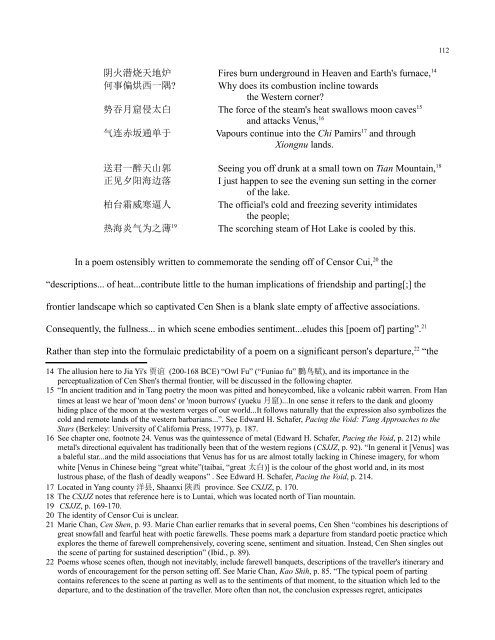View/Open - University of Victoria
View/Open - University of Victoria
View/Open - University of Victoria
You also want an ePaper? Increase the reach of your titles
YUMPU automatically turns print PDFs into web optimized ePapers that Google loves.
112<br />
阴 火 潜 烧 天 地 炉 Fires burn underground in Heaven and Earth's furnace, 14<br />
何 事 偏 烘 西 一 隅 ? Why does its combustion incline towards<br />
the Western corner?<br />
势 吞 月 窟 侵 太 白 The force <strong>of</strong> the steam's heat swallows moon caves 15<br />
and attacks Venus, 16<br />
气 连 赤 坂 通 单 于 Vapours continue into the Chi Pamirs 17 and through<br />
Xiongnu lands.<br />
送 君 一 醉 天 山 郭 Seeing you <strong>of</strong>f drunk at a small town on Tian Mountain, 18<br />
正 见 夕 阳 海 边 落 I just happen to see the evening sun setting in the corner<br />
<strong>of</strong> the lake.<br />
柏 台 霜 威 寒 逼 人 The <strong>of</strong>ficial's cold and freezing severity intimidates<br />
the people;<br />
19<br />
热 海 炎 气 为 之 薄 The scorching steam <strong>of</strong> Hot Lake is cooled by this.<br />
In a poem ostensibly written to commemorate the sending <strong>of</strong>f <strong>of</strong> Censor Cui, 20 the<br />
“descriptions... <strong>of</strong> heat...contribute little to the human implications <strong>of</strong> friendship and parting[;] the<br />
frontier landscape which so captivated Cen Shen is a blank slate empty <strong>of</strong> affective associations.<br />
Consequently, the fullness... in which scene embodies sentiment...eludes this [poem <strong>of</strong>] parting”. 21<br />
Rather than step into the formulaic predictability <strong>of</strong> a poem on a significant person's departure, 22 “the<br />
14 The allusion here to Jia Yi's 贾 谊 (200-168 BCE) “Owl Fu” (“Funiao fu” 鵩 鸟 赋 ), and its importance in the<br />
perceptualization <strong>of</strong> Cen Shen's thermal frontier, will be discussed in the following chapter.<br />
15 “In ancient tradition and in Tang poetry the moon was pitted and honeycombed, like a volcanic rabbit warren. From Han<br />
times at least we hear <strong>of</strong> 'moon dens' or 'moon burrows' (yueku 月 窟 )...In one sense it refers to the dank and gloomy<br />
hiding place <strong>of</strong> the moon at the western verges <strong>of</strong> our world...It follows naturally that the expression also symbolizes the<br />
cold and remote lands <strong>of</strong> the western barbarians...”. See Edward H. Schafer, Pacing the Void: T'ang Approaches to the<br />
Stars (Berkeley: <strong>University</strong> <strong>of</strong> California Press, 1977), p. 187.<br />
16 See chapter one, footnote 24. Venus was the quintessence <strong>of</strong> metal (Edward H. Schafer, Pacing the Void, p. 212) while<br />
metal's directional equivalent has traditionally been that <strong>of</strong> the western regions (CSJJZ, p. 92). “In general it [Venus] was<br />
a baleful star...and the mild associations that Venus has for us are almost totally lacking in Chinese imagery, for whom<br />
white [Venus in Chinese being “great white”(taibai, “great 太 白 )] is the colour <strong>of</strong> the ghost world and, in its most<br />
lustrous phase, <strong>of</strong> the flash <strong>of</strong> deadly weapons” . See Edward H. Schafer, Pacing the Void, p. 214.<br />
17 Located in Yang county 洋 县 , Shaanxi 陕 西 province. See CSJJZ, p. 170.<br />
18 The CSJJZ notes that reference here is to Luntai, which was located north <strong>of</strong> Tian mountain.<br />
19 CSJJZ, p. 169-170.<br />
20 The identity <strong>of</strong> Censor Cui is unclear.<br />
21 Marie Chan, Cen Shen, p. 93. Marie Chan earlier remarks that in several poems, Cen Shen “combines his descriptions <strong>of</strong><br />
great snowfall and fearful heat with poetic farewells. These poems mark a departure from standard poetic practice which<br />
explores the theme <strong>of</strong> farewell comprehensively, covering scene, sentiment and situation. Instead, Cen Shen singles out<br />
the scene <strong>of</strong> parting for sustained description” (Ibid., p. 89).<br />
22 Poems whose scenes <strong>of</strong>ten, though not inevitably, include farewell banquets, descriptions <strong>of</strong> the traveller's itinerary and<br />
words <strong>of</strong> encouragement for the person setting <strong>of</strong>f. See Marie Chan, Kao Shih, p. 85. “The typical poem <strong>of</strong> parting<br />
contains references to the scene at parting as well as to the sentiments <strong>of</strong> that moment, to the situation which led to the<br />
departure, and to the destination <strong>of</strong> the traveller. More <strong>of</strong>ten than not, the conclusion expresses regret, anticipates
















